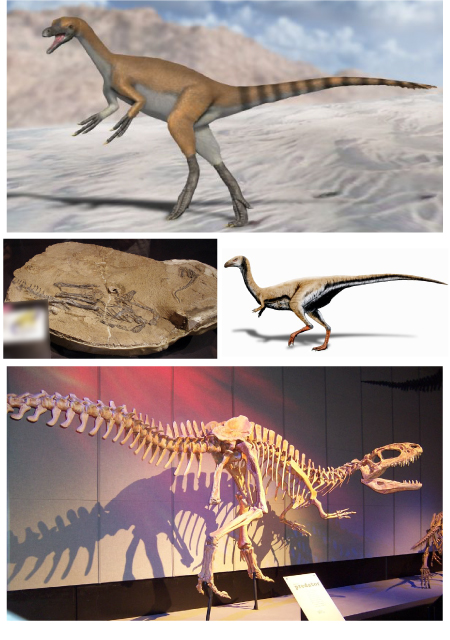高い知名度を誇るティラノサウルス類の祖先
なかでも、新疆で見つかった恐竜として日本でも知名度が高いのはグアンロン・ウーカイ(五彩冠龍:Guanlong wucaii)だろう。派手なトサカを持っていたジュラ紀後期の全長3メートルほどの獣脚類で、基盤的なティラノサウルス類であることで知られている。グアンロンの化石が見つかったのはウルムチ市の北東約100キロの場所にある昌吉回族自治州ジムサル県五彩湾の石樹溝層だ。
 グアンロンの化石 photo by ★Kumiko★ from Tokyo, Japan - File:Guanlong and Alioramus.jpg (アリオラムスとグアンロン), CC BY-SA 2.0, https://commons.wikimedia.org/w/index.php?curid=92323093
グアンロンの化石 photo by ★Kumiko★ from Tokyo, Japan - File:Guanlong and Alioramus.jpg (アリオラムスとグアンロン), CC BY-SA 2.0, https://commons.wikimedia.org/w/index.php?curid=92323093
石樹溝層からは他にも多くの恐竜が見つかっている。たとえば、羽毛を持つ小型獣脚類のハプロケイルス・ソレルス(霊巧簡手龍:Haplocheirus sollers)やリムサウルス・イネクストリカビリス(難逃泥潭龍:Limusaurus inextricabilis)、アロサウルスの仲間であるシンラプトル・ドンギ(董氏中華盗龍:Sinraptor dongi)など、獣脚類の発見例が豊富だ。
 ハプロケイルス・ソレルスの復元画*(上)、リムサウルス・イネクストリカビリスのホロタイプ標本**(中左)と復元画***、シンラプトル・ドンギの化石*****(下) photo, illustration by * Nobu Tamura (http://spinops.blogspot.com) - Own work, CC BY-SA 3.0, https://commons.wikimedia.org/w/index.php?curid=1945903; ** ssr ist4u from Ibaraki, Japan - _IGP9948Uploaded by FunkMonk, CC BY-SA 2.0, https://commons.wikimedia.org/w/index.php?curid=16251958 ; ***Nobu Tamura (http://spinops.blogspot.com) - Own work, CC BY 3.0, https://commons.wikimedia.org/w/index.php?curid=19461594 ; ****Ian Armstrong from Travelling the world at moment, Australia - 100_6837Uploaded by FunkMonk, CC BY-SA 2.0, https://commons.wikimedia.org/w/index.php?curid=19191433
ハプロケイルス・ソレルスの復元画*(上)、リムサウルス・イネクストリカビリスのホロタイプ標本**(中左)と復元画***、シンラプトル・ドンギの化石*****(下) photo, illustration by * Nobu Tamura (http://spinops.blogspot.com) - Own work, CC BY-SA 3.0, https://commons.wikimedia.org/w/index.php?curid=1945903; ** ssr ist4u from Ibaraki, Japan - _IGP9948Uploaded by FunkMonk, CC BY-SA 2.0, https://commons.wikimedia.org/w/index.php?curid=16251958 ; ***Nobu Tamura (http://spinops.blogspot.com) - Own work, CC BY 3.0, https://commons.wikimedia.org/w/index.php?curid=19461594 ; ****Ian Armstrong from Travelling the world at moment, Australia - 100_6837Uploaded by FunkMonk, CC BY-SA 2.0, https://commons.wikimedia.org/w/index.php?curid=19191433
また、剣竜の仲間のジャンジュノサウルス・ジュンガレンシス(准噶爾將軍龍:Jiangjunosaurus junggarensis)、原始的な角竜のインロン・ドウンシ(当氏隐龍:Yinlong downsi)、クラメリサウルス・ゴビネンシス(戈壁克拉美麗龍:Klamelisaurus gobiensis)をはじめとした数種類の龍脚類、また翼竜のセリシプテルス・ウツァイワネンシス(五彩湾絲綢翼龍:Sericipterus wucaiwanensis)なども見つかっている。これらの多くは今世紀に入ってからの発見だ。
 クラメリサウルス・ゴビネンシスのホロタイプ標本 By Kabacchi - Klamelisaurus - 02Uploaded by FunkMonk, CC BY 2.0, https://commons.wikimedia.org/w/index.php?curid=8913265
クラメリサウルス・ゴビネンシスのホロタイプ標本 By Kabacchi - Klamelisaurus - 02Uploaded by FunkMonk, CC BY 2.0, https://commons.wikimedia.org/w/index.php?curid=8913265
 セリスプテルスの復元イラスト By NobuTamura email:nobu.tamura@yahoo.com palaeocritti - Own work, CC BY-SA 3.0, https://commons.wikimedia.org/w/index.php?curid=19460083
セリスプテルスの復元イラスト By NobuTamura email:nobu.tamura@yahoo.com palaeocritti - Own work, CC BY-SA 3.0, https://commons.wikimedia.org/w/index.php?curid=19460083
2021年8月の最新情報
新疆での恐竜発見にまつわる最新の話題は、東部のハミ市(クムル市)の白亜紀の地層から見つかっていた3点(3体分)の部分的な恐竜化石について、『サイエンティフィック・リポーツ』誌に発表された研究成果だ。
中国側報道によると、これらの化石はいずれもティタノサウルス形類(より詳しくいえばSomphospondylan)の竜脚類で、うち2体については、それぞれ新種として報告された。
すなわち、エウヘロプス科(Euhelopodidae)の新種であるシルティタン・シネンシス(中国絲路巨龍:Silutitan sinensis)と、ティタノサウルス類(Titanosauria)の新種であるハミティタン・シンジャンゲンシス(新疆哈密巨龍:Hamititan xinjiangensis)だ。なお、日本語のカタカナ名は私がそれっぽい読みを当てただけなので、今後に別の表記がなされる可能性もある(「シルティタン」は「スールーティタン」でもいいかもしれない)。
『澎湃新聞』などが伝えるところでは、化石が見つかったのは2006年から「ハミ翼竜動物群」として知られていた翼竜化石の多い地層だ。このあたりは白亜紀には湖が広がっており、大嵐で大量の翼竜が一気に死亡して、すぐに泥のなかに多数の遺体が埋もれたのではないかとみられている。











